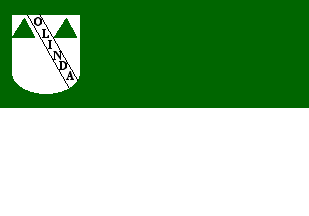![[Flag of Olinda,
PE (Brazil)]](../images/b/br-pe-ol.gif) image by André Pires Godinho and Joseph McMillan
image by André Pires Godinho and Joseph McMillan
Last modified: 2012-04-07 by ian macdonald
Keywords: pernambuco | olinda | bicolor: horizontal (blue | yellow) | coat of arms | lion: passant (red) | orb (yellow) |
Links: FOTW homepage |
search |
disclaimer and copyright |
write us |
mirrors
![[Flag of Olinda,
PE (Brazil)]](../images/b/br-pe-ol.gif) image by André Pires Godinho and Joseph McMillan
image by André Pires Godinho and Joseph McMillan
Adopted by municipal law 2388 of 20 November 1963. The colors are the traditional colors of
Duarte Coelho, first governor of Pernambuco and the city's founder in 1537.
André Pires Godinho, 22 February 2003
The municipality of Olinda (378,537 inhabitants in 2010, therefore the 3rd
most populous municipality in Pernambuco; 44 sq. km) is located in the Recife
Metropolitan Area, 7 km of Recife. One of the best preserved colonial towns in
Brazil, Olinda was registered on the UNESCO World Heritage List in 1982. The
town was the first "Brazilian Capital of Culture" (2006).
Olinda was
established by Duarte Coelho, Captain of Pernambuco since 9 March 1535, near an
Indian settlement called Marim. Located on a wide natural harbour and surrounded
by hills, the place was easy to defend; the soil was fertile and water was
abundant. The local tradition says that Duarte Coelho said "Ólinda situação
para se construir uma vila" (The beautiful location to build a village), thus
explaining the origin of the town's name. The year of foundation of the town
is unknown, but it grew so quickly that the "vila" of
Olinda was established in 1537. On 12 March 1537, Duarte Coelho sent to King
of Portugal John III the Olinda Chart ("Foral"), which listed all the
inhabited placed and inhabitants of the town. The beach was fortified and the
town increased downhill to the sea and port, and to the hinterland, where
sugar mills were set up. Timber extraction and sugar production made of
Olinda an extremely wealthy colonial town, challenging the Royal Court by its
luxury and ostentation. In the 16th century, the plan of the town was
established, the hills being settled by religious foundations. The Carmelites
(1580), the Jesuits (1583), the Franciscans (1585) and the Benedictines
(1586) used Olinda as an outpost for the conversions of the Indians and the
eventual conquest of their land. On 16 February 1630, the Dutch invaded Pernambuco. They burned down Olinda on 24 November 1631, after having taken
away all the material required to build their houses in Recife. A new
settlement was established on the islands of the harbour. The Dutch were
expelled on 27 January 1654 and Olinda was slowly rebuilt. In spite of having
been granted the status of "cidade" in 1676, Olinda was superseded by
Recife as the regional capital. The establishment of the Law Academy in 1827
and the fad of the sea baths caused the rebirth of Olinda, linked to Recife
by a tramway inaugurated in the beginning of the 20th century.
The
flag of Olinda is prescribed by Law No. 2,388, adopted in 1963. The flag is
horizontally divided blue-yellow with the modern municipal coat of arms in
the middle. The coat of arms is "Azure a globe or charged with a bend gules
ensigned with a cross or a chief of the second a lion of the third armed of
the first. The shield surmounted with a mural crown azure masoned argent". On
the flag, the horizontal division of the shield matches the horizontal
division of the flag.
The colors and elements of the flag are derived
from older local symbols. The historical coat of arms of Olinda is made of
a globe ensigned with a Latin cross, surrounded by a zodiac with the Latin
motto "Deus Salvator Noster" (God Our Savior). The coat of arms appears on
the frontispiece of the St. Sebastian church, located in Varadouro, on the
southern side of the Olinda Regional Museum and on the Rosário fountain. The
coat of arms of Duarte Coelho is "Azure a lion gules a chief argent five
stars gules a base vert a cross sable a bordure azure five castles argent",
as far as the colors can be guessed correctly from the source.
http://www.olinda.pe.gov.br/a-cidade/simbolos
Ivan Sache, 6
March 2012
 image by Ivan Sache, 6 March 2012
image by Ivan Sache, 6 March 2012
The
first modern flag of Olinda, designed by Alexandre Alves Dias, was prescribed
by Law No. 1,255, adopted in 1957. The flag is horizontally divided
green-white with, in canton, a white shield charged with two green triangles
at the top and a bend inscribed "OLINDA".
http://www.olinda.pe.gov.br/a-cidade/simbolos
Ivan Sache, 6
March 2012